Context
In Chile’s southern towns, 94% of air pollution is linked to the use of firewood at homes during winter for heating and boiling of water. Particulate matter readings exceed the current emissions threshold established by law, endangering the inhabitants that currently live in these towns. For these reasons, Chile is actively seeking alternative technologies to solve the air pollution problems and therefore, improving the quality of life in these regions.
Independencia is one of Santiago’s neighbourhoods chosen to receive technical assistance that would allow their management to identify and pursue the development of district energy related projects.
With a latitude 33.42 south and 541m above the sea level, Independencia has a global yearly solar radiation of 1,945 kWh/m2, according to the Energy Ministry weather data base, as shown in the following figure.
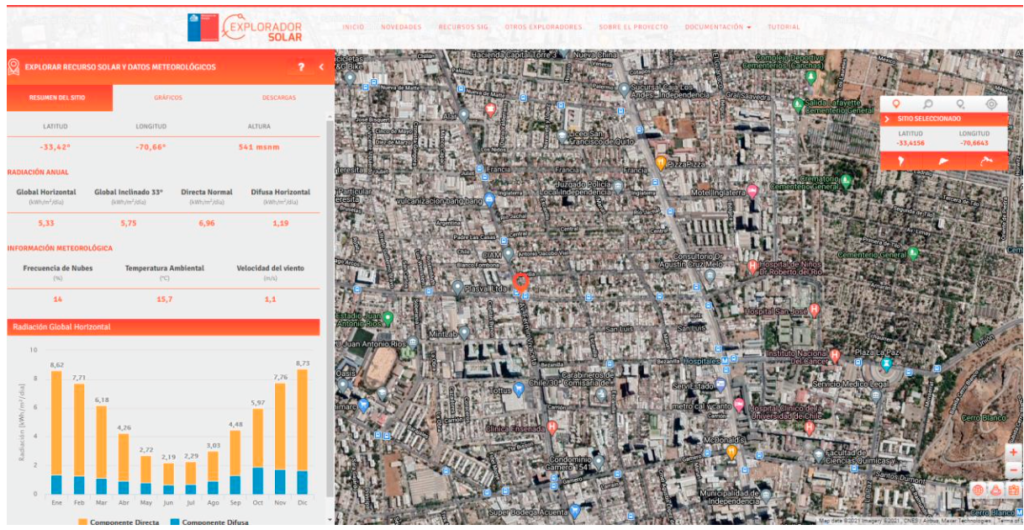
Since the focus area is in the middle of the known as “Gran Santiago”, the metropolitan area of the Chilean capital, no biomass is available and, furthermore it’s a saturated area and its use is restricted. Due to this, biomass is not considered from the very beginning.
Finally, although there’s no preliminary study or information about it in Independencia, Santiago’s underground has water wells and rivers that have been used in recent projects as source/sink focus for heat pump-based heating and cooling systems. Furthermore, last year a new regulation was approved to incentivize this kind of systems.
Area
We identified 10 buildings located close to each other: housing, office, commercial, health and education, with a total surface of 300,000m2, a cooling demand of almost 19GWh and a heating demand of 8 GWh.
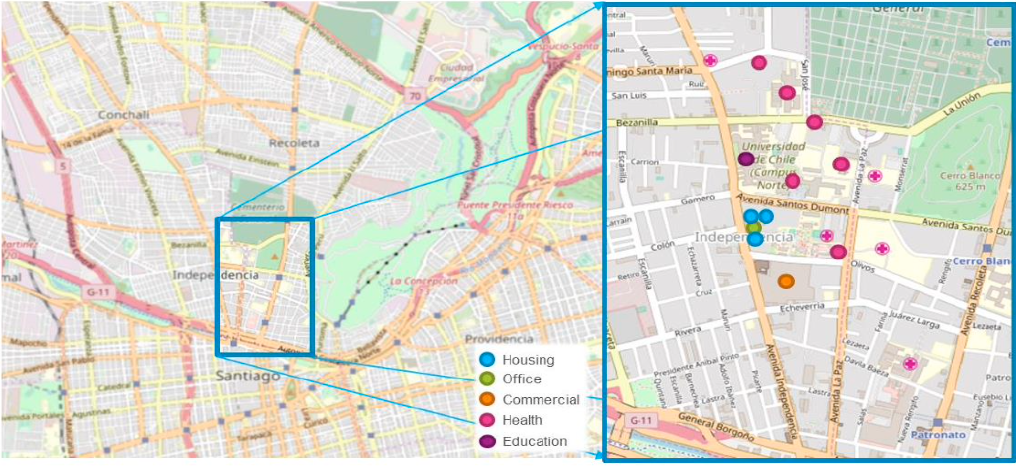
The estimated capacity of the DHC system would be 3MW heating and 7.5MW cooling, as can be seen in the following table:
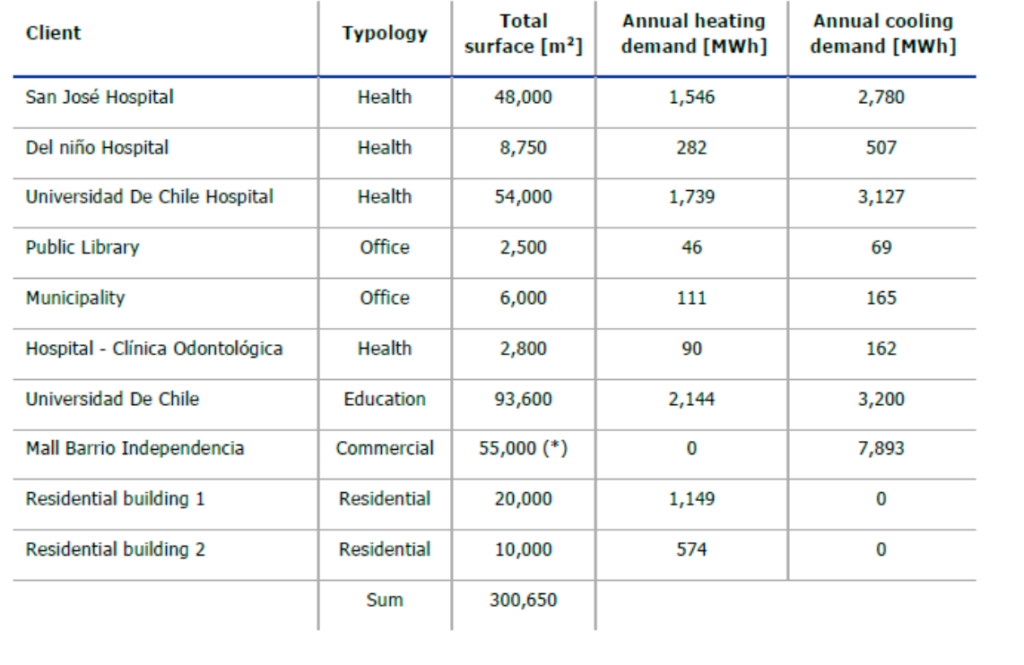
Energy demand
– Six of the expected clients are hospitals, which have a high annual demand for cooling purposes, including room temperature control for patients, equipment and specialised rooms.
– For office buildings the use of reversible heating/cooling systems has been considered.
– Shopping mall does not have heating demand, only the cooling.
– For these reasons, the collective demand of heating is significantly lower than cooling demand.
– DHW demand was not considered in this preliminary study, so that heating demand is expected to increase dramatically and to extend all along the year, in a different way that the one shown in the following figure.
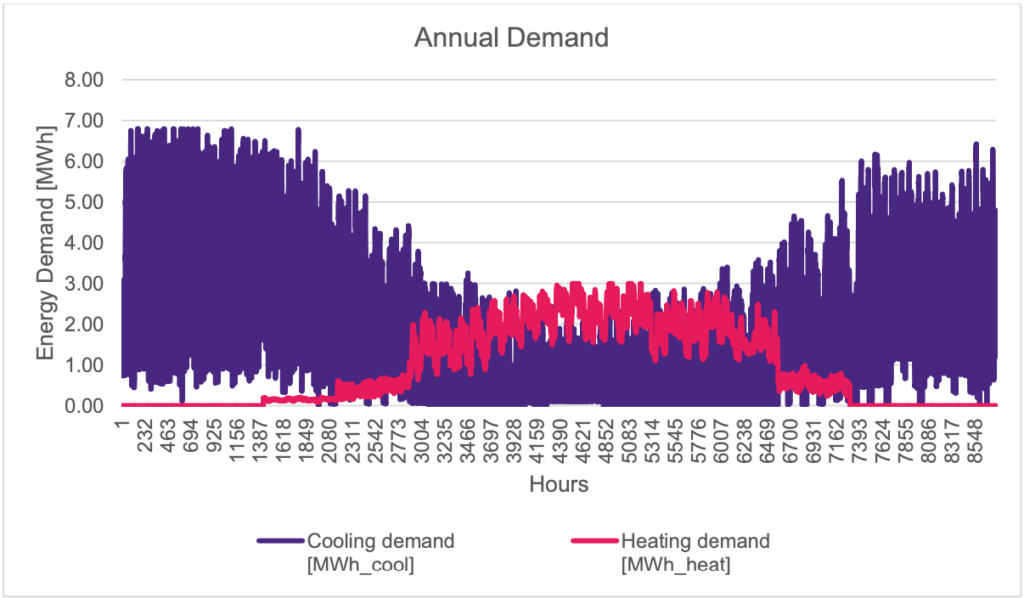
The preliminary assessment considered 4 scenarios of district energy, three of them for heating and cooling and the fourth one only for cooling. Combining CAPEX and OPEX analysis, the most promising solutions were the only cooling with chillers (air cooled) and the heating and cooling with heat pumps.


Taking into account this preliminary analysis, the non-considered DHW load and the availability of a huge solar resource as well as the potential access to underground water, solar absorption cooling and electrical heat pumps both working simultaneously for heating and cooling as well as refrigerated with water, should be considered both together and separately. Furthermore, the integration of PV with the electrical needs should also be taken into account.
Proposed technologies

Solar technologies
Massive use of solar technology in a large thermal system to drive advanced absorption chiller in summer and to produce heat in winter

Advanced Absorption chiller
Use of the advanced absorption chiller solar driven, to produce a significant part of the summer cooling demand. Cooled by underground well water or by an electrical heat pump

Electrical Heat Pump
Coupled to the advanced absorption chiller condenser, instead of the cooling tower or the cooling well, this heat pump may produce heating recovering the rejected heat

Simultaneous Electrical Heat Pump
To cover the heating and cooling base load, a well water condensed Simultaneous Electrical Heat Pump shall be the optimum complement to the Advanced Absorption chiller

Hot water storage
Optimised water storage sized for acting as solar buffer.
Proposed solutions
The combination of the different technologies generates two main solutions which will be studied in the next steps (other solutions might arise during the activity):
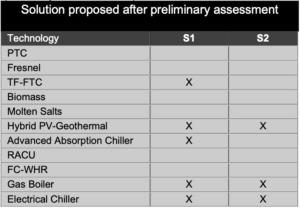
Solution 1
This combination integrates solar absorption cooling and electrical heat pumps both working simultaneously for heating and cooling as well as refrigerated with water, including also PV to cover part of the electrical needs. It also includes gas boilers and electrical chillers for peak loads
This combination is suitable for SeiMilano, since it includes the solutions already considered to provide district heating (A-W heat pump, geothermal system), district cooling (absorption chilling, possibly advanced), as well as electricity generation (PV), which are in the scope for this new DH/C demo-follower and planned to be applied to a number of 1000+ residences and possibly, offices and businesses.
Expected Impact
Use of the solar driven advanced absorption chiller
to produce a significant part of the summer cooling demand, coupled through its condenser to a water heat pump, instead of the cooling tower or the cooling well, to produce heating recovering the rejected heat.
Well water condensed electrical heat pump
produces in parallel the heating and cooling base load during the whole year, driven as far as possible by PV energy.
Large water storage devices
establish an optimised integration of the heating and cooling systems, to reach the most cost-effective operation of the whole system.
Conventional gas boilers and electrical chillers
cover the peak loads.
Solution 2
This combination integrates electrical heat pumps working simultaneously for heating and cooling as well as refrigerated with water, including also PV to cover part of the electrical needs. Furthermore it will include large water storage devices, stablishing an optimised integration to reach the most cost-effective operation of the whole system. It also includes gas boilers and electrical chillers for peak loads.
Expected Impact
Well water condensed electrical heat pump
produces in parallel the heating and cooling base load during the whole year, driven as far as possible by PV energy.
Large water storage devices
establish an optimised integration of the heating and cooling systems, to reach the most cost-effective operation of the whole system.
Conventional gas boilers and electrical chillers
cover the peak loads.
The preliminary assessment has shown promising results in terms of economic feasibility, even with the exclusion of the DHW demand analysis. Although the buildings involved in this project are owned by very different players, from both public and private sector, there is already at least one ESCO company trying to develop a DHC system to integrate all of them as customers.